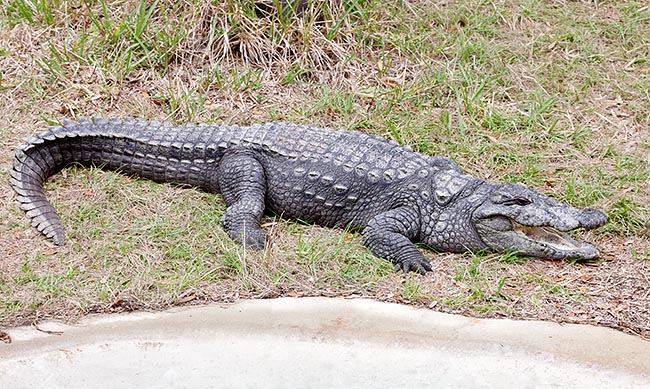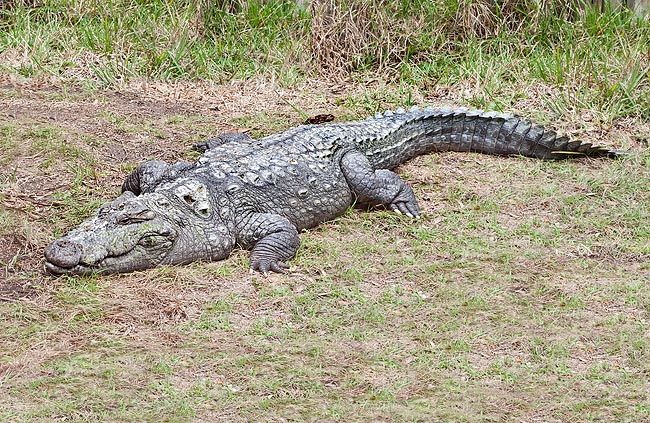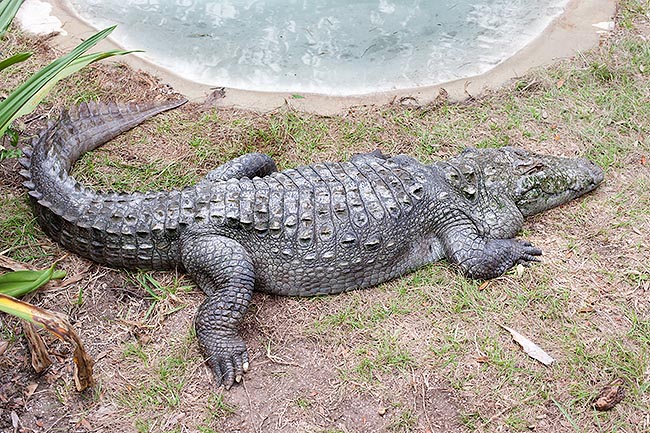Family : Crocodylidae
Subfamily : Crocodylinae

Text © DrSc Giuliano Russini – Biologist Zoologist

English translation by Mario Beltramini

Adult Crocodylus palustris eats also deer and buffaloes, but doesn't attack man © Giuseppe Mazza
The common names with which this species is called are numerous, in English, Mugger, Muggar, Marsh crocodile, Indian swamp crocodile, Broad-snouted crocodile, Makar, in Spanish, Cocodrilo marismeño, in French, Crocodile des marais, Crocodile paludéen, Crocodile palustre, in Hindi dialect, Äle Kimbula, Bhakuna, Dhakor Muhma, Ghoi, Gomua, Häle Kimbula, Magar.
The name “crocodylus”, amply treated in the other texts of the same genus, comes from the ancient Greek and means “worm-shaped pebble”, the lemma “palustris” is instead coming from the Latin and means “marshy”, in relation to the typical environments where it lives. Among the common names in English there is “Mugger”, which is a corrupted or anglicized form of the Hindi term “Magar”, meaning water monster. Some Asian school biologists consider the existence of a race or subspecies the Crocodylus palustris kimbula, in reference to the populations of this crocodile present in Sri Lanka, but most of the zoological biologists and especially the International Code for Zoological Nomenclature (ICZN), have not yet officially accepted the same. The CITES inserts it into the appendix I, whilst the IUCN states its status as “vulnerable”, that is, VU A1a, C2a. Presently, biologists estimate its population as of 5.000-10.000 specimens.
Zoogeography
It is autochthonous to Bangladesh, India, Islamic Republic of Iran, Nepal, Pakistan, and Sri Lanka and perhaps still of various areas of Indo China; in this last case censuses are under way operated by governmental biologists, in order to verify its geographic distribution.
Ecology-Habitat
The Marsh crocodile lives mainly in the freshwater rivers, lakes and swamps. In the case of the water streams, it prefers the lentic and low water flow ones; in India and in Sri Lanka, it has also adapted to live in artificial hydrographical basins, in irrigation channels and in water reservoirs. Every now and then, the biologists have observed it also salt water lagoons, thus showing a tolerance to an aquatic environment with a greater saline concentration. The Crocodylus palustris is a species sympatric to the Gavialis gangeticus, especially in some areas of the Indian subcontinent, where, however, they tend to not share same “ecological niches”, thus avoiding competition forms. During the dry season, it tends to estivate inside holes it digs filled up with water, where it rests at a lower metabolism, with lower nutritional requirements.

It reaches 5,5 m. The presence of 4 or 6 row of shields on the back leads to talk of a subspecies © Giuseppe Mazza
In the past, especially until the seventies of the XX century, the greatest threat afflicting the populations of this species were coming from the heavy hinting to which they were submitted for the utilization and the trade of their skins. Nowadays, all governments of the geographic areas where it is localized, forbid its hunting, even if, as always happens, poaching phenomena persist, with the aim of killing these animals for furnishing the skins and various organs utilized n the oriental medicine; but the pressure of the hunting action, which, even if in unlawful form still exist, is much less than in the past. Presently, on the contrary, the greatest pressure to which they are submitted, comes from the killing done by the fishermen as these reptilians tend to steal the fish entrapped in the nets, from the unlawful taking of eggs from the nests in order to be sold for gastronomic purpose or to the zoological gardens and to the crocodile farms, from the pollution of their habitats, from the explosive industrialization and urbanization, as well as from the reclamation of vast areas for having them available for the agriculture, due to the dystrophyc economic development and of increase of the human population that characterizes some of these nations, for instance, those of the Asian subcontinent and of Sri Lanka.
Biologists thin that they have nowadays disappeared in the Myanmar and in the Bangladesh. The greatest populations are found in Sri Lanka, where lives a group of even 2.000 individuals, in India, on the contrary, are present about 3.000-5.000 specimens, but distributed in more than 50 small populations. Till 1975 in India did exist much active programmes of conservation of the species, “Survival Species Programs” (SSP), or “Endangered Species Programs (ESP), by means of the creation of stations where was guaranteed the reproduction by natural coupling, as well as by artificial insemination; these procedures were followed, after a breeding time ex-situ, by the freeing of the specimens in the wild, in way to repopulate the various areas where they were reduced or even disappeared; they created protected oasis and biological reserves where to host them. But, at a certain point, the success of these programmes has increased too much their number, concurrently to the increasing reduction of the available areas, and this has induced the Indian government to stop the reproduction and the breeding in captivity with the trade of adult specimens and also of the eggs.
In other nations, as is the case of Pakistan, these programmes are on the contrary proceeding still now at full speed. The young of this species nourish mainly of aquatic arthropods, small fishes and amphibians, whilst the adults eat great fishes as well as amphibians, reptilians (serpents and also turtles), mammals (monkeys included) and also pigs and deer. Some biologists have even documented the attack done by a big specimen, to a Water buffalo (Bubalus bubalis).

It recalls the alligator for the squared muzzle and the ecology. There are only 5.000-10.000 specimens © Mazza
Morpho-physiology
The young have a bright livery presenting a cross-shaped band on the body and on the tail. The adults are dark grey and have a residual band.
Biologists define this species as medium-big. In the wild, males reach the length of 4,6-5,5 metres, females are somewhat smaller.
The muzzle is the largest among all species afferent to the genus Crocodylus, so much to grant it the look of an alligator.
Quite wide shields are present around the throat, these can have a protective function when the animal is swimming in marshy areas, similarly to what happens in American alligator (Alligator mississippiensis). The biologists have remarked that the marsh crocodile has ecology much similar to that of the American alligator, which reflects in a similar morphology.
This loricate has four scales, rather big, post-occipital, immediately behind the head. The nuchal scales, present close to the attachment of the neck, are fairly big, and are organized in way to form a square, sided in each part by two shields. It has four longitudinal lines of shields running all along the back. The Sri Lanka specimens have six of them, and from here has originated the suggestion relevant to the existence of a race or subspecies, the Crocodylus palustris kimbula. In any case, the remarkable variability in the disposition of the scheme of the nuchal scales renders difficult to utilize it as method for indentifying the possible presence of races. It has 66-68 teeth, of which 4 (more rarely, 5), are premaxillary; 14 maxillary and 15 mandibular. Although the term Mugger comes from the Hindi Magar, that is, water monster, the marsh crocodile is a fairly sociable species and in India, as for the Gharial, the population plunges in the waters where it’s present, in order to avoid the risk of any attacks.
Ethology-Reproductive Biology
The females reach the sexual maturity when their size corresponds to 1,7-2,0 m (at the age of about 6 years), males reach the same by around the 2,6 m of length (when about 10 years old). The nest, a hole, is dug by the male during the dry season, from December to February. The location is quite variable, but usually stands on the sloping sandy banks. The female usually lays 25-30 white eggs (even if they can vary from 10 to 48). In captivity, they have observed even two depositions per year, but in the wild this fact has nit yet been ascertained. The incubation period varies between 55 and 75 days; the young, upon their birth, measure about 30 cm.
The biologists have studied the action of the temperature on the sex ratio of the progeny, called “Temperature-Dependant Offspring sex-Determination” (TSD). These studies have determined that when the temperature is less than 32,5 °C, the hatching produces males only, at lower temperatures, or higher than this one, a greater percentage of females will come to life; the future babies will be only females when the incubation temperatures are of 28 or 31 °C. The mother keeps the watch to the nest and at the moment of the hatching it helps the young to get out, carrying them to the water with the mouth. The male assumes this behaviour when in captivity.
→ To appreciate the biodiversity within the CROCODYLIA and find other species please click here.
→ For general information about CROCODYLIA please click here.
